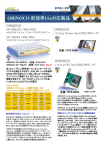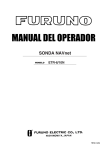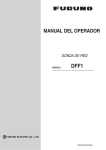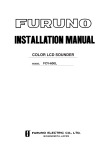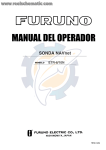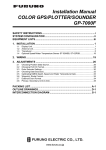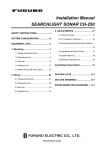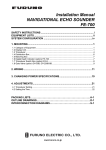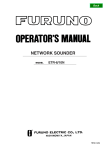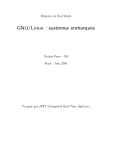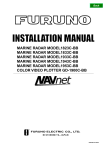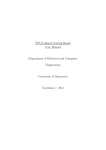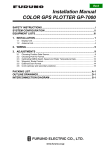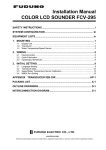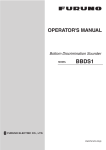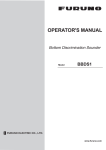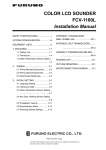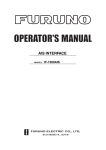Download FCV582L Installation Manual
Transcript
COLOR LCD SOUNDER MODEL FCV-582L SAFETY INSTRUCTIONS CAUTION WARNING ELECTRICAL SHOCK HAZARD Ground the equipment to prevent electrical shock and mutual interference. Do not open the equipment unless totally familiar with electrical circuits and service manual. Observe the following compass safe distances to prevent deviation of a magnetic compass: Only qualified personnel should work inside the equipment. Display unit Turn off the power at the switchboard before beginning the installation. Fire or electrical shock can result if the power is left on. Standard Steering 0.6 m 0.6 m When handling the transducer cable, keep in mind following points. . eep the cable away from oil and fuel. . Keep the cable away from the place where it may be damaged during the installation. . Do not paint the cable. The sheath of the transducer cable is made of chlorophrene rubber (or vinyl chloride). Therefore, do not paint the sheath with organic liquid (such as toluene) since it may harm the sheath. Do not install the equipment where it may get wet from rain or water splash. Water in the equipment can result in fire, electrical shock or equipment damage. Be sure no water leaks in at the transducer installation site. Water leakage can sink the vessel. Also confirm that the transducer will not loosen by ship’s vibration. The installer of the equipment is solely responsible for the proper installation of the equipment. FURUNO will assume no responsibility for any damage associated with improper installation. Be sure that the power supply is compatible with the voltage rating of the equipment. Connection of an incorrect power supply can cause fire or equipment damage. The voltage rating of the equipment appears on the label above the power connector. i i TABLE OF CONTENTS EQUIPMENT LISTS ......................................................................................................iii SYSTEM CONFIGURATION .................................................................................... iv MOUNTING 1.1 Display Unit ........................................................................................................................ 1 1.2 Thru-hull Mount Transducer 520-5PSD, 520-5MSD ......................................................... 3 1.3 Transom Mount Transducer 520-5PWD, Optional Transom Mount Triducer 520ST-PWD................................................................ 6 1.4 Inside-hull Mount Transducer 520-5PSD, 520-5MSD ....................................................... 8 1.5 Optional Water Temperature/Speed Sensors..................................................................... 11 1.6 Optional Water Temperature Sensors ............................................................................... 12 1.7 Optional Triducer 524ST-MSD, 525ST-MSD .................................................................. 14 WIRING 2.1 Wiring ............................................................................................................................... 15 2.2 Optional Sensors ............................................................................................................... 17 2.3 Optional 50 kHz and 200 kHz Transducers ...................................................................... 19 EXTERNAL EQUIPMENT SETUP 3.1 External Equipment Setup ................................................................................................ 20 APPENDIX TRIDUCER 525ST-PWC/PWD ................................................. AP-1 PACKING LIST ............................................................................................................. A-1 OUTLINE DRAWING ................................................................................................. D-1 INTERCONNECTION DIAGRAM ........................................................................ S-1 ii EQUIPMENT LISTS Standard Supply No. Name Type Code No. Qty — 1 1 Display Unit CV-582L 2 Installation Materials CP02-06100 000-015-468 1 set 3 Spare Parts SP02-03900 001-389-000 1 set 4 Accessories FP02-04800 000-015-406 1 set 520-5PSD 000-015-125 520-5MSD 000-015-127 520-5PWD 000-015-126 5 Transducer Remarks See packing list at end of manual. Inside-hull Select Inside-hull, w/8 m cable one Transom mount, w/8 m cable Optional Supply No. Name 1 Rectifier 2 Cable Assy. 3 Cable Assy. 4 5 Triducer Temperature Sensor Type PR-62 Code No. — MJ-A6SPF0012-050 000-134-424 6P-6P, 5 m MJ-A6SPF0012-100 000-133-817 6P-6P, 10 m MJ-A6SPF0011-050 000-132-244 6P-4P, 5 m MJ-A6SPF0011-100 000-132-336 6P-4P, 10 m 524ST-MSD 000-015-224 525ST-MSD 000-015-263 520ST-PWD 000-015-128 525ST-PWD 000-015-261 T-02MTB 000-040-026 With 8 m cable, transom mount T-02MSB 000-040-040 Thru-hull type T-03MSB 000-040-027 With 8 m cable, thru-hull type ST-02MSB 000-137-986 Thru-hull type ST-02PSB 000-137-987 With 8 m cable, thru-hull type 6 ST Sensor 7 Inside Hull Kit S 22S0191-0 000-802-598 8 Distributor Kit MB-1000 000-040-809 50B-6 000-015-042 50B-6G 000-015-016 200B-5 000-015-027 200B-5S 000-015-029 9 Transducer Remarks Thru-hull type Transom mount type Requires Distributor MB-1000. 10 Converter Connector 02S4089 000-133-622 8P→10P 11 Converter Connector 02S4147 000-141-082 Water temperature/Speed sensor 12 Converter Connector 02S4093 000-134-901 Transducer of AIRMAR CORP. 13 Converter Connector 02S4167 000-142-503 Extends standard transducer cable 10m. iii SYSTEM CONFIGURATION STANDARD SUPPLY OPTIONAL SUPPLY MJ-A3SPF 3P 6P DISPLAY UNIT CV-582L Navigator 6P Speed/water temperature: ST-02MSB, ST-02PSB OR Water temperature sensor: T-02MSB, T-02MTB, T-03MSB MJ-A15A3F0013-035-3A 10P 3.5m 12-24 VDC Transducer 520-5MSD 520-5PWD 520-5PSD 10P 8P 8P DISTRIBUTOR MB-1000 50B-6/6G 200B-5/5S 10P Triducer 524ST-MSD 520ST-PWD iv MOUNTING 1.1 Display Unit Mounting considerations The display unit can be installed on a tabletop or on the overhead. When selecting a mounting location for the display unit keep the following in mind: • Keep the display unit out of direct sunlight. • The temperature and humidity should be moderate and stable. • Locate the unit away from exhaust pipes and vents. • The mounting location should be well ventilated. • Mount the unit where shock and vibration are minimal. • Keep the unit away from electromagnetic field-generating equipment such as motors and generators. • For maintenance and checking purposes, leave sufficient space at the sides and rear of the unit and leave slack in cables. • A magnetcompass will be affected if placed too close to the display unit. Observe the following compass safe distances to prevent disturbance to the magnetcompass: Standard compass: 0.8 meters Steering compass: 0.6 meters Cover Tabletop Overhead Figure 1-1 Display unit mounting methods 1 Removing cover While pressing the center of the cover with your thumbs as illustrated, pull the cover towards you to remove it. Mounting procedure Attach blind film to unused knob holes. Figure 1-2 How to set the display unit to the hanger 2 1.2 Thru-hull Mount Transducer 520-5PSD, 520-5MSD Transducer mounting location This type of mounting provides the best performance of all, since the transducer protrudes from the hull and the effect of air bubbles and turbulence near the hull skin is reduced. When the boat has a keel, the transducer should be at least 30 cm away from it. Typical thru-hull mountings are shown in the figure on the next page. The performance of this sounder is directly related to the mounting location of the transducer, especially for high-speed cruising. The installation should be planned in advance, keeping the standard cable length (8 m) and the following factors in mind: • Air bubbles and turbulence caused by movement of the boat seriously degrade the sounding capability of the transducer. The transducer should, therefore, be located in a position where water flow is the smoothest. Noise from the propellers also adversely affects performance and the transducer should not be mounted nearby. The lifting strakes are notorious for creating acoustic noise, and these must be avoided by keeping the transducer inboard of them. • The transducer must always remain submerged, even when the boat is rolling, pitching or up on a plane at high speed. • A practical choice would be somewhere between 1/3 and 1/2 of the boat’s length from the stern. For planing hulls, a practical location is generally rather far astern, so that the transducer is always in water regardless of the planing attitude. Transducer outline drawings 22 24 120 120 31 All dimensions 28 in millimeters Ship's bow 74 68 520-5PSD 90 520-5MSD Figure 1-3 Dimensions of transducers 520-5PSD, 520-5MSD 3 Acceptable transducer mounting locations Deep-V hull • Position 1/2 to 1/3 length of the hull from stern • 15 to 30 cm off center line (inside first lifting strakes). Figure 1-4 Transducer mounting location on deep-V hull High speed V-planing hull • Within the wetted bottom area • Deadrise angle within 15° Figure 1-5 Transducer mounting location on high speed V-planing hull Typical thru-hull mount transducer installations Fairing block Flat washer Rubber washer Hull bottom Hull bottom Deep-V Hull Flat Hull Figure 1-6 Typical thru-hull mount transducer installations 4 Procedure for installing the thru-hull mount transducer 1. With the boat hauled out of the water, mark the location selected for mounting the transducer on the bottom of the hull. 2. If the hull is not level within 15° in any direction, fairing blocks made out of teak should be used between the transducer and hull, both inside and outside, to keep the transducer face parallel with the water line. Fabricate the fairing block as shown below and make the entire surface as smooth as possible to provide an undisturbed flow of water around the transducer. The fairing block should be smaller than the transducer itself to provide a channel to divert turbulent water around the sides of the transducer rather than over its face. Hole for stuffing tube Upper half BOW Lower half Saw along slope of hull. Figure 1-7 Construction of fairing block 3. Drill a hole just large enough to pass the threaded stuffing tube of the transducer through the hull, making sure it is drilled vertically. 4. Apply a sufficient amount of high quality caulking compound to the top surface of the transducer, around the threads of the stuffing tube and inside the mounting hole (and fairing blocks if used) to ensure watertight mounting. 5. Mount the transducer and fairing blocks and tighten the locking nuts. Be sure that the transducer is properly oriented and its working face is parallel to the waterline. Note: Do not over-stress the stuffing tube and locking nuts through excessive tightening, since the wood block will swell when the boat is placed in the water. It is suggested that the nut be tightened lightly at installation and retightened several days after the boat has been launched. 5 1.3 Transom Mount Transducer 520-5PWD, Optional Transom Mount Triducer 520ST-PWD This type of mounting is very commonly employed, usually on relatively small I/O or outboard boats. Do not use this method on an inboard motor boat because turbulence is created by the propeller ahead of the transducer. There are two methods of installation: flush with hull (for flat hulls) and projecting from hull (for deep V-hulls). D D>50 cm Flat Hull Deep V-hull Figure 1-8 Transom mount transducer mounting locations Installing the transom mount transducer flush with hull (for flat hulls) A suitable mounting location is at least 50 cm away from the engine and where the water flow is smooth. 1. Drill four pilot holes in the mounting location. 2. Attach the transducer to the bracket with tapping screws (supplied). 3. Adjust the transducer position so the transducer faces right to the seabed. Note: If necessary, to improve water flow and minimize air bubbles staying on the transducer face, incline the transducer about 5° at the rear. This may require a certain amount of experimentation for fine tuning at high cruising speeds. 4. Fill the gap between the wedge front of the transducer and transom with epoxy material to eliminate any air spaces. 6 M5 x 20 M5 x 20 5° Tape No. 1 M5 x 14 Figure 1-9 Transom mount transducer, mounting flush with hull Installing the transom mount transducer projecting from hull (for deep-V hulls) This method is employed on deep-V hulls and provides good performance because the effects of air bubbles are minimal. Install the transducer parallel with water surface; not flush with hull. If the boat is placed on a trailer care must be taken not to damage the transducer when the boat is hauled out of the water and put on the trailer. M5 x 20 M5 x 20 No. 2 M5 x 14 Figure 1-10 Transom mount transducer, projecting from hull Transducer preparation Before putting the boat in water, wipe the face of the transducer thoroughly with a detergent liquid soap. This will lessen the time necessary for the transducer to have good contact with the water. Otherwise the time required for complete “saturation” will be lengthened and performance will be reduced. Do not paint the transducer. Performance will be affected. 7 1.4 Inside-hull Mount Transducer 520-5PSD, 520-5MSD Necessary tools You will need the following tools: • Sandpaper (#100) • Silicone sealant • Silicone grease Remarks on installation • Turn off the engine and anchor the boat while installing the equipment. • Install the transducer in the engine room. Selecting the mounting location Keep the following points in mind when selecting a mounting location: • The mounting location should be where the hull is of singlehull thickness and is void of air or flotation materials other than solid fiberglass between the transducer face and the water. • Do not place the transducer over hull struts or ribs which run under the hull. • Avoid a location where the rising angle of the hull exceeds 15°, to minimize the effect of the boat’s rolling. • You will finalize the mounting location through some trial and error. The procedure for this is shown later. Center line 50cm 50cm 1/2 1/3 15cm 15cm Mounting location for transducer Figure 1-11 Inside-hull transducer mounting location 8 Attaching the transducer 1. Clean the transducer face to remove any foreign material. Lightly roughen the transducer face with #100 sandpaper. Also, roughen the inside of the hull where the transducer is to be mounted. 2. Warm the silicone sealant to 40°C before usage to soften it. Coat the transducer face and mounting location with silicone sealant. Transducer face Silicone sealant Figure 1-12 Coating the transducer face with silicone sealant 3. Press the transducer firmly down on the hull and gently twist it back and forth to remove any air which may be trapped in the silicone sealant. Squeeze out air bubbles. Hull Silicone sealant Figure 1-13 Attaching transducer to hull with silicone sealant 9 Checking the installation 1. Connect the battery to the display unit as shown on page 15. 2. Turn on the display unit. 3. Operate the MODE control to select LF or HF. 4. Press the GAIN control to select OFF (if it is not already selected). 5. Set the gain to “5” with the GAIN control. 6. Operate the RANGE control to set the range to 30 feet. 7. If the bottom is displayed in red and the depth indication appears the mounting location is suitable. You can leave the transducer in position. --.-°C ---kt 50k 0.0 0 2 Transmission line 4 6 Reddishbrown Bottom 8 Depth 6.5 10 Figure 1-14 Sounder display 8. If the bottom is not displayed in red, the mounting location is unsuitable. Do the following: 1) Press the POWER key to turn off the power. 2) Gently dismount the transducer with a piece of wood. 3) Reattach the transducer elsewhere as shown in “Attaching the transducer.” 4) Check the installation again. Final preparation Support the transducer with a piece of wood to keep it in place while it is drying. Let the transducer dry 24–72 hours. 10 1.5 Optional Water Temperature/Speed Sensors Through-hull mount water temperature/speed sensor ST-02MSB, ST-02PSB Select a suitable mounting location considering the following: • Select a mid-boat flat position. The sensor does not have to be installed perfectly perpendicular. The sensor must not be damaged in dry-docking operation. • Select a place apart from equipment generating heat. • Select a place in the forward direction viewing from the drain hole, to allow for circulation of cooling water. • Select a place free from vibration. 1. Dry-dock the boat. 2. Make a hole of approx. 51 mm diameter. 3. Unfasten locknut and remove the sensor section. 4. Apply high-grade sealant to the flange of the sensor. 5. Pass the sensor casing through the hole. 6. Face the notch on the sensor toward boat’s bow and tighten the flange. 7. Set the sensor section to the sensor casing and tighten the locknut. 8. Launch the boat and check for water leakage around the sensor. Locknut Face "notch" toward bow. 51 Flange nut Coat with silicone sealant. 123 Brim ø77 Figure 1-15 Water temperature/speed sensor ST-02MSB, ST-02PSB 11 1.6 Optional Water Temperature Sensors Transom mount water temperature sensor T-02MTB • Fix the cable at a convenient location with cable clamp. • When the cable is led in through the transom board, make a hole of approx. 17 mm diameter to pass the connector. After passing the cable, fill the hole with a sealing compound. D D>50 cm M5 x 20 Mount sensor flush with hull bottom. Figure 1-16 How to install transom mount water temperature sensor T-02MTB 12 Thru-hull mount water temperature sensor T-02MSB, T-03MSB • Select a mid-boat flat position. The sensor does not have to be installed perfectly perpendicular. The sensor must not be damaged in dry-docking operation. • Select a place apart from equipment generating heat. • Select a place in the forward direction viewing from the drain hole, to allow for circulation of cooling water. • Select a place free from vibration. T-02MSB T-03MSB Sensor Holder Sensor cable Locknut Locknut Washer Gasket Locknut Washer Gasket φ25 mm φ21 mm Coat with sealant. Mounting procedure 1. Drill a hole of 21 mm in diameter in the mounting location. 2. Pass the sensor cable through the hole. 3. Pass gasket, washer and locknut onto cable in that order. 4. Coat the sensor flange with high quality sealant and then fasten the sensor with the locknut. (Torque: max. 59N·m) 5. Launch the boat to check for water leakage around the sensor. Coat with sealant. Holder Guide Plate thickness within 25 mm Mounting procedure 1. Drill a hole of 25 mm in diameter in the mounting location. 2. Coat holder guide with high quality sealant, and pass gasket, washer and locknut onto holder guide in that order and then tighten the locknut. 3. Set the sensor holder to the holder guide from inside the boat and then tighten the locknut. 4. Launch the boat to check for water leakage around the sensor. Figure 1-17 Thru-hull mount water temperature sensors T-02MSB, T-03MSB 13 1.7 Optional Triducer 524ST-MSD, 525ST-MSD The triducer is designed for thru-hull mounting. Mounting considerations When selecting a mounting location keep the following points in mind: • Air bubbles and turbulence caused by movement of the boat seriously degrade the sounding capability of the transducer. The transducer should, therefore, be located in a position where water flow is the smoothest. Noise from the propellers also adversely affects performance and the transducer should not be mounted nearby. The lifting strakes are notorious for creating acoustic noise, and these must be avoided by keeping the transducer inboard of them. • The transducer must always remain submerged, even when the boat is rolling, pitching or up on a plane at high speed. • A practical choice would be somewhere between 1/3 and 1/2 of the boat’s length from the stern. For planing hulls, a practical location is generally rather far astern, so that the transducer is always in water regardless of the planing attitude. ∅79 mm 133 mm 2.00"-12 UN threads 7 mm ∅51 mm 27 mm 140 mm Figure 1-18 Dimensions of triducer 524ST-MSD 14 WIRING 2.1 Wiring All wiring are terminated at the rear of the display unit. DISPLAY UNIT Ground terminal External equipment Black Ground White Shield TRANSDUCER BATTERY Figure 2-1 Display unit, rear view Power cable Connect the power cable to the power connector. Connect the leads to the battery (12 or 24 VDC); white to plus(+) terminal and black to minus(-) terminal. Cable connector Power cable w/fuse (3A) Lead wire Black White BATTERY Figure 2-2 Connecting the power cable to the battery 15 Transducer, optional triducer Connect the transducer cable to the XDR connector. Ground Connect the ground wire (KIV 2.0sq, 2 m, supplied) to ship’s ground to prevent interference to the picture. Shorten the ground wire as much as possible. For FRP vessels, install a ground plate that measures about 20 cm by 30 cm on the outside of the hull bottom to provide a ground point. CAUTION Ground the equipment to prevent mutual interference. Note: Use a “closed” lug to make the ground connection at the ). display unit. Do not use an “open-type” lug ( Attaching EMI cores Attach EMI cores to the power cable and transducer cable to prevent noise. 1. Tape the power cable and transducer cable where the EMI core is to be attached, to fix the core. 2. Attach cores where tape is placed on respective cables. EMI core Figure 2-3 How to attach EMI cores 16 2.2 Optional Sensors Water temperature sensor Connect the transducer cable to the XDR connector. Connect the water temperature sensor (option) or water temperature/speed sensor (option) to the XDR connector with the converter connector (Type : 02S4147, Code No. : 000-141-082, option). MJ-A6SRMD MJ-A10SPF SHIELD TEMP TEMP0V NC NC NC 1 4 7 3 2 5 6 8 9 10 1 2 3 4 5 6 MJ-A10SRMD NC NC NC NC NC NC NC XDR+ XDR SHIELD XDR- 1 2 3 4 5 6 7 8 9 10 NC TEMP TEMP0V NC NC NC NC XDR+ XDR SHIELD XDR- Figure 2-4 Connection of water temperature speed sensor Connection of water temperature/speed sensor MJ-A6SRMD SHIELD TEMP TEMP0V/SPD0V SPD +V NC MJ-A10SPF 1 2 3 4 5 6 MJ-A10SRMD 1 2 NC NC NC NC NC NC NC XDR+ XDR SHIELD XDR- 4 7 3 1 2 5 6 8 9 10 TEMP TEMP0V SPD0V/ SHIELD SPD +12.7V NC NC XDR+ XDR SHIELD XDR- 3 4 5 6 7 8 9 10 Figure 2-5 Connection of water temperature/speed sensor 17 Connect to XDR connector at rear of display unit MJ-A10SPF MJ-A6SRMD MJ-A10SRMD Tape connector with self-vulcanizing tape and then vinyl tape to waterproof connector. Bind tape end with cable tie. Water temp., water temp/speed sensor connector Transducer connector Figure 2-6 Connection of transducer, water temperature sensor, water temperature/speed sensor NMEA data sentences 18 Input/Output Data Sentence INPUT: L/L, Course, Speed, Waypoint Range/Bearing, Water Temperature, Cross-Track Error RMA, RMB, RMC, BWC, GLL, MTW, VTG, VHW, XTE OUTPUT: Depth, Water Temperature, Speed Output every 2 sec. DBT (Ver. 1.5) DPT (Ver. 2.0) MTW, VHW 2.3 Optional 50 kHz and 200 kHz Transducers To connect optional transducer 50B-6, 50B-6G, 200B-5 or 200B5S, the optional Distributor Kit (MB-1000, code no. 000-040-809) is required. Additionally, an 8P-10P converter connector (02S4089, code no. 000-133-622) is required to connect to the display unit. Fasten the cable from the Distributor to the XDR connector on the display unit. TRANSDUCER 02P6168 50kHz J2 50B-6/50B-6G SHIELD RED 200kHz Jumper block setting J2: No output restriction J1: Output restriction RED BLK BLK J1 TB2 1 2 3 4 TB1 Shield WHT 3 2 1 BLK 5 200B-5/200B-5S To display unit (cable is fitted with 8P connector. 8P-10P converter connector is required.) Figure 2-7 Distributor MB-1000 Name Type Code No. Qty Distributor MB-1000 000-040-805 1 Crimp-on Lug FV1.25-3 Red 000-538-113 6 Cord Lock NC-1 1 000-516-650 Remarks Cable w/8P connector supplied for connection to display unit For use with separate transducer 19 EXTERNAL EQUIPMENT SETUP This chapter shows you how to set up the FCV-582L when external equipment is connected. If a water temperature/speed sensor is installed, you should complete this section with the boat in the water and running, to confirm speed/water temperature readout. Display the system menus as shown below, and then follow appropriate procedure(s) on the next page. Finish by resetting the power and checking for proper display of data. 3.1 External Equipment Setup Displaying the system menu 1, system menu 2 1. Select MENU by operating the MODE control. 2. Press the [▼] key to select GO TO SYSTEM MENU. SYSTEM MENU 1 MENU 1 2 3 DEPTH UNIT m ft fa pb SPEED UNIT kt MPH km/h TEMP UNIT ° C ° F ZOOM MARK OFF ON F/A LEVEL WEAK MED STRG TEMP GRAPH OFF ON LANG English DISP SEL GRA1 GRA2 DAT DRAFT 0.0 [-20 +20] TX OUTPUT MIN MAX ▲▼ : To select item - + : To set condition SIG LEV : ESCAPE SYSTEM MENU 2 MENU 1 2 3 [+] at NAV DSP OFF L/L R/B CSE "MENU 1" NMEA Ver1.5 Ver2.0 BEARING TRUE MAG SPD SEL OFF OWN NMEA [–] at TMP SEL OFF OWN NMEA "MENU 2" SPD ADJ 0 % [-50 +50] TMP ADJ 0.0 °F [-20 +20] (ADJUSTABLE OWN SENSOR ONLY) OWN SENSOR OWN SENSOR TEMPERATURE SPEED – –. – kt – –. – °F To select item - + : To set condition SIG LEV : ESCAPE ▲▼ : Figure 3-1 System menu 1, System men 3. Press the [+] key at GO TO SYSTEM MENU. The System menu 1 appears. You can switch between these menus with the [+] and [–] keys when the MENU field is selected. 4. Follow appropriate procedure(s) on the next page. 20 Draft setup 1. At the System menu 1 press the [▼] key to select DRAFT. 2. Press the [+] or [–] key to set draft. For example, if the depth readout is 5 feet lower than actual depth, enter +5 feet. Navigator setup 1. At the System menu 2, press the [▼] key to select NMEA. 2. Press the [+] or [–] key to select NMEA input format of navigator; Ver. 1.5 or Ver. 2.0. (If you are unsure of the version no., try both and select the one which successfully inputs nav data to the sounder.) 3. To display nav data on the sounder displays, press the [▲] key to select NAV DSP. 4. Press the [+] or [–] key to select which nav data to display; L/ L (Position), R/B (Range and Bearing to a Waypoint), or CSE (Course). Speed data setup 1. At the System menu 2, press the [▼] key to select SPD SEL. 2. Press the [+] or [–] key to select source of speed data; OWN (speed sensor) or NMEA. 3. For speed sensor-equipped sets, you may offset the speed readout if it is wrong. Run the boat at various speeds and watch the speed readout at the bottom of the screen. If it is unreasonably wrong, press the [▼] key to select SPD ADJ. 4. Press the [+] or [+] key to correct speed readout. For example, if the readout is 10% higher than actual speed, enter -10. Water temperature data setup 1. At the System menu 2, press the [ ▼] key to select TMP SEL. 2. Press the [+] or [–] key to select source of water temperature data; OWN (water temperature sensor) or NMEA. 3. For water temperature sensor-equipped sets, you may offset the water temperature readout if it is wrong. Watch the water temperature readout at the bottom of the screen. If it is unreasonably wrong, press the [▼] key to select TMP ADJ. 4. Press the [+] or [–] key to correct water temperature readout. For example, if the readout is 2° higher than actual temperature, enter -2°. 5. To display a water temperature graph (shows present water temperature), press the [▲] key to select MENU and press the [–] key to select 1. The System menu 1 appears. 6. Press the [▼] key to select TEMP GRAPH. 7. Press the [+] key to select ON. 21 Confirming indications 1. Reset the power. 2. Confirm that appropriate data appears on the display. Speed Water temperature Nav data (position) 22.6°C 12kt 35°15.000’N 135°07.500’E 200k 0.0 0 30 Water temperature scale Water temperature marker (orange) 20 20 10 0 49.6 40 60 80 Figure 3-2 Location of speed, water temperature and nav data indications 22 APPENDIX TRIDUCER 525ST-PWC/PWD This appendix provides a copy of the installation instructions for AIRMAR triducer. If you loose the original supplied with the triducer, use this appendix. INSTALLATION INSTRUCTIONS Transom Mount Transducer or TRIDUCER Multisensor with Integral Release Bracket Model P66 R Record the information found on the cable tag for future reference. Part No._______ Date_______ Frequency_______kHz U.S. Patents: 4,555,938; 4,644,787; 5,606,253; Des. 334,335 Canadian Patent 1,233,341 TRIDUCER R multisensor IMPORTANT: Please read the instructions completely before proceeding with the installation. These instructions supersede any other instructions in your instrument manual if they differ. CAUTION: NEVER USE SOLVENTS Cleaners, fuel, paint, sealants, and other products may contain strong solvents, such as acetone, which attack many plastics greatly reducing their strength. Applications • Not recommended for boats with large or twin screw inboard engine(s) • Good operation up to 44 kn (50 MPH) • Vertically orients sound beam on hull with deadrise angle up to 30° Adjusts to transom angles from 2°- 22° Bracket protects sensor from frontal impact only • • Tools and Materials Scissors Masking tape Safety goggles Dust mask Electric drill Drill bits: Bracket holes Fiberglass hull 4 mm, #23, or 9/64” chamfer, countersink, 6 mm, or 1/4” Transom hole (optional) 20 mm or 13/16” Cable clamp holes 3 mm or 1/8” Marine sealant Screwdrivers Straight edge Pencil Zip-ties Water-based antifouling paint (mandatory in salt water) Transducer Pretest Speed and Temperature Functions Connect the multisensor to the instrument and spin the paddlewheel. Check for a speed reading (and the approximate air temperature if applicable). If there is no reading or it is inaccurate, return the instrument to your place of purchase. Mounting Location To ensure the best performance, the sensor must be in contact with aeration-free and turbulence-free water. Mount the sensor on the transom as close to the centerline (keel) of the boat as possible. On slower heavier displacement hulls, positioning it farther from the centerline is acceptable. Headroom – Allow adequate space above the bracket for it to release and rotate the sensor upward (see Figure1). Caution: Do not mount in an area of turbulence or bubbles: Near water intake or discharge openings; Behind strakes, struts, fittings, or hull irregularities; Behind eroding paint (an indication of turbulence). Caution: Avoid mounting the sensor where the boat may be supported during trailering, launching, hauling, or storage. • Single drive boat – Mount on the starboard side at least 75 mm (3”) beyond the swing radius of the propeller (see Figure2). • Twin drive boat – Mount the sensor between the drives. min.: 127 mm (5") headroom max. with speed sensor: 213 mm (8-1/2") max. no speed sensor: 191 mm (7-1/2") Figure1. Stepped hull - headroom required at mounting location Figure2. Mounting location on single drive boat 75 mm (3") minimum beyond swing radius AP-1 APPENDIX TRIDUCER 525ST-PWC/PWD Installation Hole Drilling Figure 3. Template for starboard side of boat Drill at locations labeled "B" for transom angles 16° through 22° (most small aluminum boats) B B B A A A Drill at locations labeled "A" for transom angles 2° through 15° (most boats) Align arrow with bottom of transom Align template vertically 1. Cut out the template (see Figure3). 2. At the selected location on the starboard side of the hull, position the template, so the arrow at the bottom is aligned with the bottom edge of the transom (see Figure4). Being sure the template is parallel to the waterline, tape it in place. Warning: Always wear safety goggles and a dust mask. 3. Using a 4 mm, #23, or 9/64” bit, drill three holes 22 mm (7/8”) deep at the locations indicated. To prevent drilling too deeply, wrap masking tape around the bit 22 mm (7/8”) from the point. Fiberglass hull – Minimize surface cracking by chamfering the gelcoat. If a chamfer bit or countersink bit is not available, start drilling with a 6 mm or 1/4” bit to a depth of 1 mm (1/16”). Plastic Shim • Standard transom (13°transom angle) – The bracket is designed for a standard 13°transom angle. The shim is not needed for this installation. Skip to “Mounting the Bracket”. • Stepped transom and jet boats (3°transom angle) – Use the shim with the tapered end down. • Small aluminum and fiberglass boats (20°transom angle) – Use the shim with the tapered end up. • If you are unsure about using the shim, do one of the following: • Measure the transom angle of your boat using a digital level or bubble level and protractor. Then follow the instructions above for your transom angle. • Experiment with the shim. Follow the instructions: “Mounting the Bracket”, “Attaching the Sensor to the Bracket”, and “Checking the Sensor Angle and Projection”. Mounting the Bracket slope of hull parallel to waterline Align template arrow with bottom edge of transom Figure4. Template position bracket screw self-tapping screw 1. Apply marine sealant to the threads of the three, #10 x 1-3/4”, self-tapping screws to prevent water seepage into the transom (see Figure5). Screw the bracket (and shim if needed) to the hull. Do not tighten the screws. 2. Using the vertical adjustment space on the bracket slots, slide the bracket up or down until the distance between the bottom left corner and the bottom of the transom equals 41 mm (1-5/8”). Tighten the screws. mounting ears closed actual size screws (self-tapping #6 x 5/8") actual size co ve r ho us in g speed sensor opened tab in slot slope of hull cover flush with housing cover 41 mm (1-5/8") insert screwdriver here to remove cover transducer housing Figure5. Distance between corner of bracket and bottom of transom AP-2 Figure6. Speed sensor or blank some installations Figure7. Cover some installations Figure8. Bracket retaining cover APPENDIX TRIDUCER 525ST-PWC/PWD Stepped Hull Installation Only If there is insufficient headroom under the step for the multisensor to fully release, remove the cover before proceeding (see Figure1, maximum headroom). This is necessary to access the bracket screws at a later time. 1. Remove the two screws that hold the speed sensor onto the transducer housing (see Figure6). 2. The paddlewheel assembly is a loose slip fit. Carefully, slide the speed sensor upward while keeping the paddlewheel assembly inside (see Figure13). 3. Insert a blade screwdriver between the cover and the transducer housing (see Figure7). Pry each side apart, in turn. 4. Lift the cover up and off. slot (2) A B close & latch retaining cover pivot post (2) Attaching the Sensor to the Bracket Caution: The retaining cover must be closed and latched to prevent the sensor from coming off the bracket when the boat is underway. 1. If the retaining cover is closed, open it by depressing the latch and rotating the cover downward (see Figure8). 2. Insert the sensor’s pivot posts into the slots in the top of the bracket (see Figure9). Push down until the posts click into place. 3. Rotate the sensor downward until it snaps onto the bracket. 4. Close the retaining cover by rotating it upward until it latches. Figure9. Attaching the sensor to the bracket 2° - 10° transom angle shim with taper down 11° transom angle NO SHIM YES 19° - 22° transom angle shim with taper up YES YES Checking the Sensor Angle and Projection Caution: Do not position the bow of the sensor lower than the stern because aeration will occur. Caution: Do not position the sensor farther into the water than necessary to avoid increasing drag, spray and water noise, and reducing boat speed. 1. Using a straight edge, sight the underside of the sensor relative to the underside of the hull (see Figure10). The stern of the sensor should be 1-3 mm (1/16 – 1/8”) below the bow of the sensor or parallel to the bottom of the hull. 2. Check that the bottom left corner of the sensor projections 3 mm (1/8”) below the bottom of the hull (see Figure11). 3. If the sensor needs adjustment, release it upward (see “Releasing the Sensor” below). Adjust the bracket. Tighten the screws. parallel Attaching the Cover & Blank or Speed Sensor (some installations) 1. Spread the sides of the cover horizontally (see Figure7). 2. Slide the cover up and over the mounting ears. 3. Push the cover down until it sits flush on the transducer. 4. Squeeze the sides of the cover until the tabs snap into the slots. 5. Insert the side rails of the speed sensor or blank into the channels on the back of the transducer housing (see Figure6). Slide it downward. Fasten the speed sensor or blank in place with the two, #6 x 5/8”, self-tapping screws. Testing on the Water 1. Become familiar with your echosounder’s performance at a speed of 4 kn (5 MPH). 2. Gradually increase the boat speed and observe the gradual decline in performance due to turbulent water flowing over the transducer’s active surface. parallel 12° - 18° transom angle NO SHIM NO YES NO slight angle angle reversed Releasing the Sensor Do one of the following (see Figure12): • Using the palm of your hand, give a sharp upward blow to the underside of the transducer housing. Do not hit the speed sensor. • Insert a blade screwdriver between the transducer housing and the bottom of the bracket (either side). Push up on the screwdriver while lifting up on the sensor. parallel angle too steep Figure10. Sensor angle adjustment cable screw actual size insert screwdriver at bevel (either side) cable cover cable clamps 50 mm (2") Hull projection 3 mm (1/8") Figure11. Vertical adjustment and cable routing give sharp blow with palm of hand Figure12. Releasing the sensor AP-3 APPENDIX TRIDUCER 525ST-PWC/PWD 3. If the degradation is sudden (not gradual), identify the boat speed at which the onset occurred. Return the boat to this speed, then gradually increase speed while making moderate turns in both directions. 4. If the performance improves while turning, the transducer’s position probably needs adjustment. It is probably in aerated water. Move the transducer farther down into the water in increments of 3 mm (1/8”). If the performance does not improve satisfactorily, move the sensor closer to the centerline of the boat. Full unused screw holes with marine sealant. High-speed operation (above 40 MPH) may require less projection in the water to improve performance and reduce the chance that water pressure will cause the bracket to release. speed sensor housing shaft insert shaft through short side hole B in of blade retaining bar (2) Cable Routing Route the sensor cable over the transom, through a drain hole, or through a new hole drilled in the transom above the waterline. Caution: Never cut the cable or remove the connector; this will void the warranty. Warning: Always wear safety goggles and a dust mask. 1. If a hole must be drilled through the transom, choose a location well above the waterline (see Figure11). Check for obstructions such as trim tabs, pumps, or wiring inside the hull. Mark the location with a pencil. Drill a hole using the appropriate size bit to accommodate the connector. 2. Route the cable over or through the transom. 3. On the outside of the hull secure the cable against the transom using the cable clamps. Position a cable clamp 50 mm (2”) above the bracket and mark the mounting hole with a pencil. 4. Position the second cable clamp halfway between the first clamp and the cable hole. Mark this mounting hole. 5. If a hole has been drilled in the transom, open the appropriate slot in the cable cover. Position the cover over the cable where it enters the hull. Mark the two mounting holes. 6. At each of the marked locations, use a 3 mm or 1/8” bit to drill a hole 10 mm (3/8”) deep. To prevent drilling too deeply, wrap masking tape around the bit 10 mm (3/8”) from the point. 7. Apply marine sealant to the threads of the #6 x 1/2” self-tapping screws to prevent water from seeping into the transom. If you have drilled a hole through the transom, apply marine sealant to the space around the cable where it passes through the transom. 8. Position the two cable clamps and fasten them in place. If used, push the cable cover over the cable and screw it in place. 9. Route the cable to the instrument being careful not to tear the cable jacket when passing it through the bulkhead(s) and other parts of the boat. To reduce electrical interference, separate the sensor cable from other electrical wiring and the engine(s). Coil any excess cable and secure it in place with zip-ties to prevent damage. 10. Refer to you echosounder owner’s manual to connect the sensor to the instrument. Antifouling Paint Marine growth can accumulate rapidly on the sensor’s surface reducing performance within weeks. Surfaces exposed to salt water that do not interlock, must be coated with antifouling paint. Use water-based antifouling paint only. Never use ketone based paint, since ketones can attack many types of plastic possibly causing damage to the transducer. Apply paint every 6 months or at the beginning of each boating season. AP-4 side view BOW Figure13. Servicing the speed sensor Checking for Leaks Warning: When the boat is placed in the water, immediately check for leaks around the screws and any holes drilled in the hull. Never install a sensor and leave the boat in the water unchecked for several days. Maintenance, Repair, & Parts Cleaning Clean the sensor with a soft cloth and mild household detergent. If fouling occurs, use a stiff brush or putty knife to remove the growth being careful to avoid scratching the bottom of the transducer. In severe cases, wet sand the sensor (and paddlewheel) with fine grade wet/dry paper. Servicing the Speed Sensor If the paddlewheel becomes fouled or inoperable, it can be cleaned. Remove the two screws from the speed sensor (see Figure13). Slide it upward to remove it from the transducer housing. Grasp the two retaining bars and pull to access the shaft. After cleaning, slide the paddlewheel onto the shaft. Orient the short side of the paddlewheel blade as shown on the side view. It must be oriented correctly to measure the boat’s speed. Fit the shaft into the holes marked “B” in the retaining bars. Note: There is a left retaining bar marked with an L and a right retaining bar marked with an R. Slide the assembly into the speed sensor housing. Note: The interior of the housing is marked with a corresponding L and R. Re-attach the speed sensor. Parts Replace broken or worn parts immediately. The water-lubricated paddlewheel bearings have a life of up to 5 years on low-speed boats [less than 10 kn (11 MPH)] and 2 years on high-speed vessels. Some depth/temperature units can be upgraded by adding a speed sensor. Purchase parts from you marine dealer or instrument manufacturer. Part Number Part Paddlewheel Kit 33-473-01 Bracket and Wedge Kit 33-475-01 Speed Sensor Kit 33-346-03 Sensor Replacement The information needed to order a replacement sensor is printed on the cable tag. Do not remove this tag. When ordering, specify the part number, date, and frequency in kHz. A−1 02FG-X-9851 -7 PACKING LIST 1/1 FCV-581L/582L N A M E ユニット O U T L I N E DESCRIPTION/CODE № Q'TY UNIT CV-581L-J-50KHZ 指示器 1 DISPLAY UNIT 000-015-464 ** 予備品 SPARE PARTS SP02-03900 FGBO-A 3A AC125V ヒューズ 3 FUSE 000-549-063 付属品 ACCESSORIES FP02-04800 03-118-1103-0 ブラインドフィルム(K) 1 DUMMY FILM(K) 100-185-380 FP02-04802 ハードカバー 1 HARD COVER 001-389-020 5X20 SUS304 1シュ +トラスタッピンネジ 4 +TAPPING SCREW 000-802-081 工事材料 INSTALLATION MATERIALS CP02-06110 ESD-SR-150 フィルタ(EMI) 2 FILTER 000-149-159 その他工材 OTHER INSTALLATION MATERIALS MJ-A15A3F0013-035-3A ケーブル組品MJ 1 POWER CABLE 000-145-880 図書 DOCUMENT IMJ-23580-* 装備要領書(和) 1 INSTALLATION MANUAL 000-808-269 ** OMJ-23580-* 取扱説明書(和) 1 OPERATOR'S MANUAL 000-808-267 ** 1.コ-ド番号末尾の[**]は、選択品の代表型式/コードを表します。 CODE NUMBER ENDED BY "**" INDICATES THE NUMBER OF TYPICAL MATERIAL. (略図の寸法は、参考値です。 DIMENSIONS IN DRAWING FOR REFERENCE ONLY.) 02FG-X-9851 C B IV-8SQ *1 MB-1000 50B6/6G 200B5/5S 5 2 1 4 3 注記 *1)現地手配 *2)工場にて取付済み *3)オプション *4)変換ケーブル組品が必要。 *5)どちらか一方のみ。 *6)両端コネクタ付ケーブル。 NOTE *1. LOCAL SUPPLY. *2. FITTED AT FACTORY. *3. OPTION *4. THREE-WAY CONVERSION CABLE NEEDED (OPTION). *5. EITHER ONE CAN BE CONNECTED. *6. CABLE W/ CONNECTOR BOTH ENDS. 50B-6/6G 200B-5/5S 56 (−) 整流器 (+) RECTIFIER *3 PR-62 12 *1 *2 FUSE 3A MJ-A3SPFD FOR FCV-582L CV-582L MJ-A10SPF 10P 02S4089 8P 8P FM-214-8P DPYC-1.5 FOR FCV-581L CV-581L MJ-A10SPF 10P 02S4089 8P 8P 02S4069 4P 4P 100/110/ 220/230VAC, 1φ,50/60Hz 12/24 VDC MJ-A15A3F0013-035-3A φ6, 3.5m シロ WHT クロ BLK DWG.No. SCALE APPROVED CHECKED C2362-C01- D kg Takahashi T. 1 2 3 4 5 6 8m±0.5m *2 MJ-A10SPFD *2 MJ-A10SRMD P P *2 MJ-A6SPFD *2 MJ-A10SPF3A 520-5PSD 520-5MSD 520-5PWD *3 送受波器 TRANSDUCER K.MIYAZAWA MASS NMEA J3 TD-H TD-C RD-H NMEA0183 (Ver1.5/2.0) RD-C NC FG *3 02S4167-0 10m Y. Hatai Jan. 8 '04 GND *1 IV-1.25SQ (+) (-)10.2-31.2VDC FG DRAWN 1 2 3 POWER J1 XDR NMEA *3 *6 64S4073-1,5m,6P-6P 64S4071-1,10m,6P-6P 03S9202-1,5m,6P-4P 03S9226-1,10m,6P-4P SPD +12.7V SPD0V/SHIELD TEMP NC NC TEMP0V XDR+ XDR SHIELD XDR- NAME 名称 TITLE 水温・船速センサー付 送受波器 TRANSDUCER W/ SENSOR *3 520ST-PWD 524ST-MSD 1 2 3 4 5 6 7 8 9 10 指示器 DISPLAY UNIT CV-600L CV-581L CV-582L MJ-A6SRMD A GND 50K FG GND 200K J2 SPD +12.7V SPD0V/SHIELD TEMP NC NC TEMP0V XDR+ XDR SHIELD XDR1 2 3 4 5 6 7 8 9 10 1 2 3 4 5 6 7 8 9 10 航法装置など NAVIGATION DEVICE, ETC. 4 MJ-A10SPFD XDR 3 MJ-A6SRMD *4 相互結線図 COLOR LCD SOUNDER INTERCONNECTION DIAGRAM FCV-600L/581L/582L カラーLCD魚探 T-02MTB 520ST-PWD T-03MSB *5 524ST-MSD *3 T-02MSB *3 水温センサー 水温・船速センサー TEMP SENSOR TEMP/SPEED SENSOR 1 2 3 4 5 6 2 1 TEMP TEMP0V 4 7 1 2 3 4 5 6 J2 SPD +12.7V SPD0V/SHIELD TEMP NC NC TEMP0V XDR+ XDR SHIELD XDR1 2 3 4 5 6 7 8 9 10 MJ-A10SRMD 520-5PSD 520-5MSD 520-5PWD 送受波器 TRANSDUCER 8 9 10 1 c n = Y o s D N : H a t a i Y o s h i t o s h i : 電 子 署 名 者 H a t a i Y o s h i t o s h i 署 名 は 検 証 さ れ て い ま せ ん 。 S-1 The paper used in this manual is elemental chlorine free. Your Local Agent/Dealer 9-52 Ashihara-cho, Nishinomiya 662-8580, JAPAN Telephone : 0798-65-2111 Fax 0798-65-4200 : All rights reserved. Printed in Japan FIRST EDITION : APR APR.. 1998 H2 Pub. No. IME-23590-H2 ( HIMA ) FCV-582L : MAR. MAR. 16, 2005 *00080827400* *00080827400* *00080827400* *IME23590H20* *IME23590H20* *IME23590H20*




































